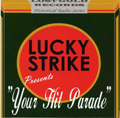
Back Your Hit Parade Spanish Your Hit Parade Finnish 유어 히트 퍼레이드 Korean Your Hit Parade Serbo-Croatian Your Hit Parade SIMPLE
| Your Hit Parade | |
|---|---|
 | |
| Genre | Music |
| Directed by | Norman Jewison (1958-59) |
| Starring | Dorothy Collins Snooky Lanson Gisele MacKenzie Russell Arms Eileen Wilson June Valli Sue Bennett Virginia Gibson Alan Copeland Tommy Leonetti Jill Corey Johnny Desmond Raymond Scott Frank Sinatra |
| Narrated by | Andre Baruch |
| Country of origin | United States |
| Original language | English |
| Production | |
| Producers | Dan Lounsbery, Ted Fetter |
| Running time | 25 minutes |
| Original release | |
| Network | NBC (1950–1958) CBS (1958–1959) |
| Release | July 10, 1950 – April 27, 1959 |
| Infobox instructions (only shown in preview) | |
Your Hit Parade was an American radio and television music program that was broadcast from 1935 to 1953 on radio, and seen from 1950 to 1959 on television. It was sponsored by American Tobacco's Lucky Strike cigarettes. During its 24-year run, the show had 19 orchestra leaders and 52 singers or groups.
When the show debuted, there was no agreement on its title. The press referred to it by several names, with the most common being "Hit Parade", "The Hit Parade", "The Lucky Strike Hit Parade",[1] and "The Lucky Strike Parade".[2] The program title officially became "Your Hit Parade" on November 9, 1935.[3]
Every Saturday evening, the program offered the most popular and bestselling songs of the week. The earliest format involved a presentation of the top 15 songs. Later, a countdown with fanfares led to the top three finalists, with the number one song for the finale. Occasional performances of standards and other favorite songs from the past were known as "Lucky Strike Extras".
Listeners were informed that the "Your Hit Parade survey checks the best sellers on sheet music and phonograph records, the songs most heard on the air and most played on the automatic coin machines, an accurate, authentic tabulation of America's taste in popular music." However, the exact procedure of this "authentic tabulation" remained a secret. Some believe song choices were often arbitrary due to various performance and production factors. The show's ad agencies—initially Lord and Thomas and later Batten, Barton, Durstine & Osborne—never revealed the specific sources or the methods that were used to determine top hits. They made a general statement that it was based mainly on "readings of radio requests, sheet music sales, dance-hall favorites and jukebox tabulations"; Radio Guide claimed "an endless popularity poll on a nationwide scale."[4]
- ^ see for example "Lucky Strike Hit Parade is Popular", Laredo (Texas) Times, May 21, 1935, p. 7
- ^ Bette Davis on "The Tonight Show With Johnny Carson", February 12, 1982. Rerun February 14, 2022.
- ^ "Al Goodman to Be Maestro on Radio Series," Oakland Tribune, November 9, 1935, p. 14.
- ^ Dunning, John (1998). On the Air: The Encyclopedia of Old-Time Radio (Revised ed.). New York, NY: Oxford University Press. pp. 738–740. ISBN 978-0-19-507678-3. Retrieved 2019-08-17.